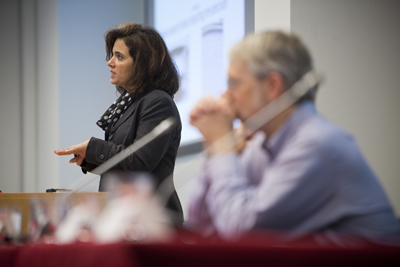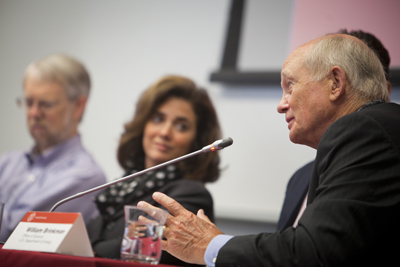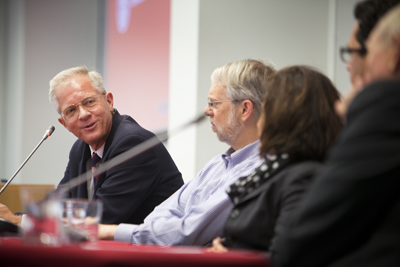Impact of nanotechnology heard globally at online briefing
By Anne Ju



Some of Cornell's leading nanoscience researchers expounded on the promises and challenges of their fields during a mostly virtual online briefing for journalists July 20.
The panel of experts, gathered in 226 Weill Hall, spent an hour chatting with journalists, from Minnesota Public Radio to The Chronicle of Higher Education, and answering such questions as: What are the challenges associated with scaling up nanoscale electronics? And, what is the relationship between nanoscience and sustainability?
The event also served as a wrap-up of the Cornell NanoScale Science and Technology Facility (CNF) 35th anniversary, marked by a series of academic speakers and research presentations the previous day.
Each panelist provided listeners with a general flavor of their areas of expertise. Juan Hinestroza, associate professor of fiber science and apparel design, described his focus on the interface between natural and synthetic materials at the nanoscale, particularly cellulose. Hinestroza has led efforts into bridging fashion design and nanoscience: His students have made dye-free clothing infused with nanoparticles to take on colors, antibacterial properties or even electrical conductivity.
The field of panelist Michal Lipson, associate professor of electrical and computer engineering and member of the Kavli Institute at Cornell for Nanoscale Science, is called silicon photonics and aims to greatly decrease power consumption of computers by using optics instead of electrical wires as interconnects. These so-called nano waveguides will enable optics to become part of the next generation of microelectronics, she said.
And Chris Ober, professor of materials science and engineering, discussed new techniques his group is investigating for making nanostructures, such as a new nanoparticle photoresist, as well as application of lithography to the developing area of polymer electronics.
Also joining the panel was Roger Howe, director of the National Nanotechnology Infrastructure Network (NNIN) and faculty director of the Stanford Nanofabrication Facility. Howe talked about how the National Science Foundation-supported NNIN, of which CNF is the flagship member, connects nanofabrication and other infrastructure resources with researchers all over the world.
The final panelist was William Brinkman, director of the Office of Science at the U.S. Department of Energy, who described the DOE's particular commitment to nanoscience research as a means of addressing energy-related challenges including battery technology and solar power. Brinkman was also the July 19 CNF anniversary keynote speaker.
Media Contact
Get Cornell news delivered right to your inbox.
Subscribe